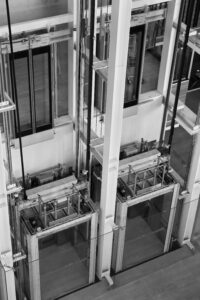 In recent years, there has been a growing trend toward architectural projects that focus on building upward instead of sprawling outward. When land is limited, particularly in urban areas, this is the most efficient use of space and resources. In Chicago alone, the number of active high-rise construction sites more than doubled (from 14 to 34) from October 2014 to January 2016. Designing multi-story buildings requires architectural teams to carefully plan elevator systems that meet current safety standards, as well as address the unique needs of the space. The following article will discuss some of the mechanical, electrical, plumbing, and fire protection considerations for designing a safe and efficient elevator system.
In recent years, there has been a growing trend toward architectural projects that focus on building upward instead of sprawling outward. When land is limited, particularly in urban areas, this is the most efficient use of space and resources. In Chicago alone, the number of active high-rise construction sites more than doubled (from 14 to 34) from October 2014 to January 2016. Designing multi-story buildings requires architectural teams to carefully plan elevator systems that meet current safety standards, as well as address the unique needs of the space. The following article will discuss some of the mechanical, electrical, plumbing, and fire protection considerations for designing a safe and efficient elevator system.
TYPES OF ELEVATORS

When designing for an elevator system, it is important to first determine which type of elevator suits the project’s needs. Hydraulic and traction elevators have different requirements and specifications, and building height is a major factor in which one is appropriate for a project.
Hydraulic
Pumps that are generally 30-40 horsepower move hydraulic fluid under a piston to raise this type of elevator – then return fluid back into the tank to lower the elevator. Hydraulic elevators are advisable for shorter buildings, up to five stories. They also contain flammable liquid and must feature appropriate fire alarm and protection devices.
Traction
Traction elevators, on the other hand, are suspended by tensile cable and balanced by counterweights equal in weight to a half-loaded elevator. They are raised and lowered by moving the cable Motors are usually 15-20 horsepower. Traction elevators are common for buildings that have more than five stories. Traction elevator machinery has traditionally been located in penthouse spaces above the elevator shaft; however, “machine room-less” elevators are now available for buildings up to 150 feet tall. This centralizes all machinery within the shaft, saving the client the cost of building a dedicated penthouse space.
SMOKE CONTROL
Modern buildings are designed to contain a fire to the location where it starts, and floor plates generally are rated to prevent movement of smoke and growth of a fire. For this reason, care must be taken with shafts that penetrate multiple floor levels since they are susceptible to collecting smoke from a fire or transferring smoke from floor to floor. Smoke control normally is operated automatically by the fire alarm system, but firefighters need the ability to override the system. Because of this, smoke control is required to be annunciated and manually operated from a firefighter’s smoke control panel.
Hoistway Ventilation
In the past, hoistway ventilation was the main approach to smoke control. When smoke was detected in an elevator shaft or lobby, vents in the top of the shaft would open to discharge smoke. Hoistway ventilation is becoming less preferable because it can exacerbate problems through stack effect, drawing smoky air from the fire floor through the shaft.
Hoistway Pressurization
Pressurization is an alternative smoke control solution, which begins when a building’s fire alarm system is activated. It works by positively pressurizing the hoistway and pushing air outward through any opening, avoiding smoke infiltration.
EMERGENCY POWER
Emergency power is a primary concern in new building design, especially since high-rise buildings are becoming more commonplace, and they are simply not accessible without elevators.
Electrical Power Requirements
In most jurisdictions, a high-rise is defined as a building with an occupied floor set more than 75 feet above the lowest level of access from a fire department vehicle. Backup power systems are required for high-rise buildings and are usually powered by generators. Emergency lighting, including elevator cab lighting, is considered an emergency load, while elevator motors are backed up by generators as standby loads.
All high-rise buildings must have standby power for elevators, but not all elevators have to be capable of running at once during an outage. Generators should therefore be large enough to operate only one elevator in a group. Elevator controllers should also be programmed to operate just one elevator at a time while on backup power.
FIRE SAFETY
 Fire safety for elevator system design has changed dramatically in recent decades. Modernizations have been developed to solve life-threatening problems present in older systems.
Fire safety for elevator system design has changed dramatically in recent decades. Modernizations have been developed to solve life-threatening problems present in older systems.
Elevator Recall
Elevator recall is a control system that prevents occupants from unwittingly riding an elevator to a floor with a fire. It is now required among almost all elevators, both old and new.
PHASE 1 | In the first phase, Emergency Recall, the elevator descends to the level of egress (primary level recall). If the fire is on the main floor, the elevator goes down to another level (alternate level recall).
PHASE 2 | The second phase of elevator recall, in-cab operation, enables firefighters to use recalled elevators to reach a fire. A warning light will alert firefighters if a fire in the elevator machine room has made an elevator ineligible to use. The need for this critical system component has become clear in situations where fires have broken out in older buildings without recall. In a 2012 case in Chicago, a fire in a 21-story building resulted in the death of a resident when the elevator took her to the floor containing the fire. The building was constructed in 1952 and lacked elevator recall.
LOBBIES & FIRE SERVICE ACCESS
Fire-rated, enclosed elevator lobbies are required for hoistways in non-sprinklered buildings with more than three floors, as well as institutional occupancy buildings or sprinklered high-rises. High-rise buildings with an occupied floor located more than 120 feet above
the lowest level of fire department access must also have at least two fire service access elevators (or one if there’s only one elevator in the building).
SELF-EVACUATION ELEVATORS
 Buildings with a height greater than 420 feet need to have an extra egress stairway, unless occupant self-evacuation elevators (with standby power) are available. Awareness about the importance of self-evacuation elevators has grown since the September 11, 2001 attacks. Typically, during an emergency, building occupants are urged to evacuate using the stairs. But in the case of a high-rise with more than 100 stories and thousands of occupants – some of whom may not be able-bodied – this is not a feasible option. Stairwells get backed up, and evacuation is slowed dangerously down at a time when every second counts. Egress from a building 40 stories or higher can take more than an hour. New high-rise constructions are now including self-evacuation elevators that are protected from fire and smoke, allowing occupants to flee a building safely much more quickly than using the stairs. Building self-evacuation elevators also is a far more economical option than adding egress stairways to every floor of a high-rise.
Buildings with a height greater than 420 feet need to have an extra egress stairway, unless occupant self-evacuation elevators (with standby power) are available. Awareness about the importance of self-evacuation elevators has grown since the September 11, 2001 attacks. Typically, during an emergency, building occupants are urged to evacuate using the stairs. But in the case of a high-rise with more than 100 stories and thousands of occupants – some of whom may not be able-bodied – this is not a feasible option. Stairwells get backed up, and evacuation is slowed dangerously down at a time when every second counts. Egress from a building 40 stories or higher can take more than an hour. New high-rise constructions are now including self-evacuation elevators that are protected from fire and smoke, allowing occupants to flee a building safely much more quickly than using the stairs. Building self-evacuation elevators also is a far more economical option than adding egress stairways to every floor of a high-rise.
SPRINKLER SYSTEMS & FIRE ALARMS
Earlier versions of fire protection codes for elevator systems required sprinklers in all hoistways, elevator pits and machine rooms. But newer code requirements are less focused on sprinkler systems and have more emphasis on fire-resistant and non-flammable construction. Newer codes also discourage sprinklers in elevator spaces, leaving them open for evacuation or fire department operations during a fire.
Smoke Detectors
Smoke detectors are usually obligatory for all elevator operation or access spaces, as well as within 21 feet of any hoistway door and in elevator machine rooms.
Shunt Trips
Shunt trips must be in place wherever sprinklers are present inside the elevator hoistway or machine room. This is a precaution to allow removing power before the sprinkler system is activated.


